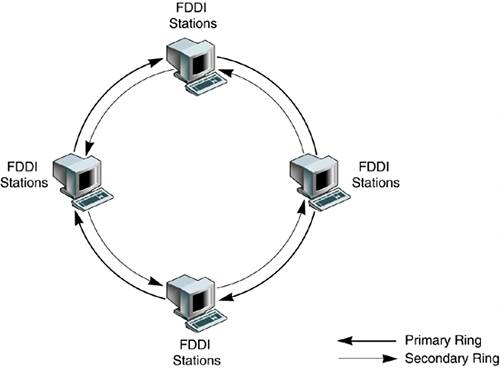In the realm of computer networking, the Fiber Distributed Data Interface (FDDI) stands out as a key technology that ushered in a new era of data transfer. With its dual ring topology, FDDI introduced innovations that provided robust fault tolerance, ensuring minimal disruptions. At the heart of this system lies the Primary Ring. This article sheds light on the significance of the Primary Ring, its function within FDDI, and its relevance in today’s network architectures.
In this article:
- Understanding FDDI’s Dual Ring Topology
- The Magic of Redundancy
- The Evolution of Fault-Tolerant Systems
- Conclusion
- References
1. Understanding FDDI’s Dual Ring Topology
FDDI uses a unique dual ring topology, composed of the Primary Ring and the Secondary Ring. This architecture ensures that data flows seamlessly, even in the face of network faults or failures.
- Primary Ring: As the name suggests, this is the main conduit for data transfer in an FDDI network. Under normal conditions, data travels only on the Primary Ring. It becomes the backbone, ensuring that data packets reach their destinations efficiently.
- Secondary Ring: This is the backup or safety net of the FDDI network. It springs into action when there’s a fault in the Primary Ring. Interestingly, data on the Secondary Ring travels in the opposite direction, providing an alternative path and ensuring the network’s resilience.

2. The Magic of Redundancy
The genius behind FDDI’s dual ring topology lies in its redundancy. By having two separate rings, FDDI ensures that even if one ring faces an issue, the other can take over, allowing for uninterrupted data transfer.
- Fault Tolerance: With two rings in play, if the Primary Ring encounters a fault or failure, the Secondary Ring instantly becomes active. This seamless transition ensures that the network remains operational, minimizing potential downtime.
- Enhanced Reliability: Running the Primary and Secondary Rings along different physical paths further amplifies the system’s redundancy. This separation means that a physical disruption impacting one ring (like an accident or natural disaster) won’t necessarily affect the other, keeping the network alive.
3. The Evolution of Fault-Tolerant Systems
While FDDI and its dual ring topology were revolutionary during their time, the world of networking has evolved. Modern networks, while drawing inspiration from systems like FDDI, now employ a variety of techniques and technologies to ensure fault tolerance and high availability.
- Mesh Networks: Today’s networks often use mesh topologies, where each device (or node) is connected to multiple other devices. This setup provides multiple data paths, enhancing fault tolerance.
- Software-Defined Networking (SDN): SDN allows for dynamic network reconfiguration. In case of a fault, SDN can reroute data through alternative paths, ensuring continued data flow.
- Cloud Redundancy: Modern cloud infrastructures are designed with redundancy in mind. Data is often replicated across multiple servers or even geographical locations, ensuring its availability even if one server or data center faces an outage.
4. Conclusion
The Primary Ring in FDDI networks stands as a testament to the innovative spirit of early network designers. It highlighted the importance of redundancy and fault tolerance, principles that remain at the core of modern network design. As we journey through the ever-evolving landscape of computer networking, understanding foundational concepts like the Primary Ring provides valuable context. It’s a nod to our technological heritage and a reminder of the importance of reliability in connecting our digital world.